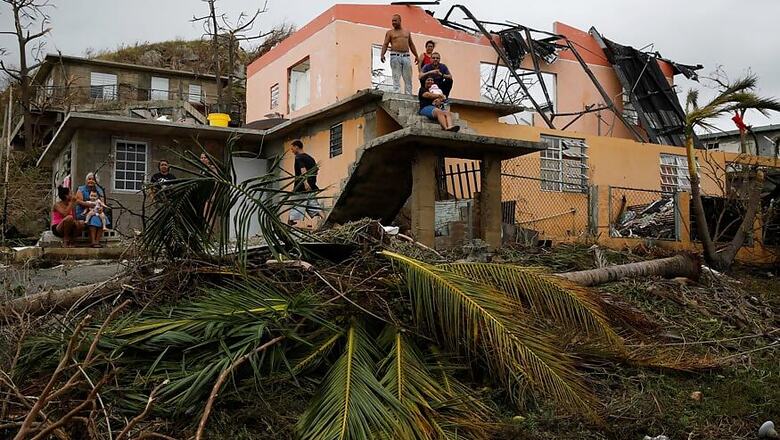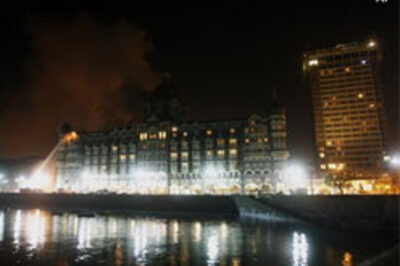
views
San Juan: Some 70,000 people were ordered to evacuate their homes Friday after a rain-swollen dam in Puerto Rico failed in the latest disaster caused by Hurricane Maria.
With the death toll from the storm at 33 across the Caribbean, the National Weather Service office in San Juan issued a flash flood warning for people living along the Guajataca River in the northwest of the island and said the 1920s earthen dam was in danger of collapsing altogether.
"All Areas surrounding the Guajataca River should evacuate NOW. Their lives are in DANGER!," the service said in a tweet. Flooding has already begun downstream, it said.
Shortly thereafter, Governor Ricardo Rossello issued an order for some 70,000 people living in the area to get out.
According to the newspaper El Vocero, Public Safety Secretary Hector Pesquera said a drain that normally releases a stream of water from the dam in a controlled fashion had broken.
So instead, the busted drain sent water gushing down a sort of ramp-style conduit and eventually washing away huge chunks of soil from the grassy green slope of the dam, according to video on the WeatherNation website.
However the flash flood warning only lasts until 0600 GMT, the weather service said, suggesting that the river waters were going down.
Puerto Rico was already battling dangerous floods after Hurricane Maria ravaged the island early Wednesday. Rescuers raced against time to reach trapped residents.
Rossello has called Maria the most devastating storm in a century after it destroyed the US territory's electricity and telecommunications infrastructure.
Rossello told CNN the island is lacking communications and the preliminary assessment at this point is 13 fatalities.
"Right now our efforts are to make sure we have everybody safe, that we can rescue people. Our efforts have already produced almost 700 rescues so we're clearly focused on that."
The National Hurricane Center said some areas in Puerto Rico could see 40 inches (more than a meter) of rain from Maria, and Rossello warned of dangerous mudslides brought on by the deluge.
"We have a lot of flooding, we have reports of complete devastation of vulnerable housing. Of course it's still raining over here."
SOS text
Maria has been blamed for at least 33 deaths, including 15 in Dominica, three in Haiti and two in Guadeloupe.
After lamenting that Puerto Rico had been "absolutely obliterated" by Maria, US President Donald Trump spoke with Governor Rossello Thursday night and promised to speed up relief efforts.
Although the southeast coast suffered the worst damage, no part of the island escaped the storm's wrath, including the capital San Juan where there was widespread flooding.
The city's mayor, Carmen Yulin Cruz, said the biggest need was getting emergency medication and supplies to vulnerable people who are stranded in their homes.
"Yesterday we were canvassing and we found elderly people that don't have blood pressure medicine, food," she said.
"I got an SOS from (an elderly home) and it was a text like from a horror movie. It said if anybody can hear us, please, we are stuck here and we can't get out and we have no power and we have very little water left. We got there just in time."
Network crippled
The torrential rain had turned some roads into muddy brown rivers, impassable to all but the largest of vehicles.
Toppled trees, street signs and power cables were strewn across roads that were also littered with debris.
Puerto Rico's electricity network has been crippled by the storm and engineers say it could take months for power to be fully restored.
The local electricity board has promised that their priority will be to restore power to hospitals, water treatment plants and pumping stations.
Brock Long, who heads the US federal government's emergency management agency FEMA, said that ships carrying millions of meals and bottled water were trying to dock as the island's ports are slowly reopened.
As of Friday evening, Maria was a Category Three hurricane with winds of 125 miles per hour (205 kilometers per hour), churning in the sea some 300 miles east of the central Bahamas.
Heavy rains and high winds began hitting the archipelago on Thursday afternoon.
The government opened new shelters after several buildings which had been used during Hurricane Irma earlier this month were damaged and authorities feared they might not hold up under another fierce storm.
Maria previously tore through several Caribbean islands, claiming the highest toll on Dominica, which has a population of around 72,000 and has been largely cut off from the outside world.




















Comments
0 comment